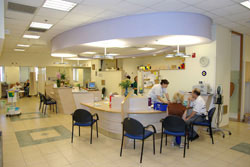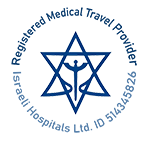Department for the treatment of urogenital tumors

About the Department
The medical team of the Department consists of specialists in the areas of clinical oncology, radiation therapy, urology and surgery.
Close cooperation among these professionals and variety of available treatments, including results of the latest clinical research, allows the team to develop a competent and comprehensive treatment program for each patient.
Solid practical experience of the attending professionals, their past academic and practical specialization in oncology of urogenital system are helping to the patients overcome problems associated with the diseases of urogenital system, to keep quality of their life and provide follow-up observation.
Cancers of prostate, bladder, kidney and testis are diseases that are included in the spectrum of clinical and research divisions of the Department.
Prostate Cancer
Prostate cancer is the most common cancer among males in the Western World and is the second leading cause of male mortality.
1500 to 2000 new cases of prostate cancer are recorded annually In Israel. Thanks to modern diagnostic techniques and continuously improved treatment used in the Department, the number of deaths from the prostate cancer is significantly reduced.
A huge role in this positive statistics is improved methods for the early diagnosis.
Treatment options for prostate cancer:
- the latest methods of treatment that still under the evaluation in the clinical trials
- surgery to remove prostate cancer, conducted by surgeons urologists
- radiotherapy and brachytherapy carried out within the Radiotherapy
Department, which is the leading Department among of its kind in the world of medical practice - a wide range of hormonal treatment
- chemotherapy
Bladder Cancer
Bladder cancer ranks as a fifth in the Cancer list of Israel.
Men, especially smokers, are at two-fold risk to develop bladder cancer than the general population.
Smoking is a major risk factor for this disease. Poisonous and toxic substances released during smoking, accumulate in the urine and over the years affected the bladder lining and lead to the cancer.
The disease is affecting mostly people older than 50 years. As a rule, initially, the disease is diagnosed because of the patient complaints on the appearance of blood in the urine. At the early stages of the disease (primary site) urological surgery is performed with very high, up to 95% five-year survival, efficiency.
Patients, who are discovered with secondary foci, are undergo systemic chemotherapy, corresponding to the highest standards of reliability and safety.
Cancer of kidney
According to Israeli statistics, about 600 people a year are affected by the kidney cancer In 70% of the cases they have been diagnosed at the initial stage, and about 20% of them gave the metastases.
In the eighties, the disease was detected, usually only in the last stages. Today, thanks to modern diagnosis, the tumor can be found at the initial stage of development.
The appearance of metastases is absolutely dependent on the size of the tumor:
- The tumor size of less than 7cm will give metastases in 5% of cases.
- The tumor size of more than 7cm will give metastases in 25% of cases.
- The tumor that spread outside the kidney would metastasize in 50% of cases.
- The involvement of the nearly located lymph nodes will give metastases in 70% of cases.
Smoking is the most significant risk factor for the disease. The male population is affected by kidney cancer twice higher than the female population.
Age (older than 50 years), high blood pressure and genetically inherited Von Hippel Lindau syndrome are additional risk factors for the disease.
Renal Cell Carcinoma (RCC) is the most common type of kidney cancer, which is consists of dozens of subgroups, the main of which is renal cell carcinoma (80% of cases).
In the primary (local) development of the disease it is carried out by surgical removal.
Methods of operation may be different: abdominal and laporoscopical.
Recently, the Department uses a number of new and effective drugs for the treatment of patients with metastasized kidney cancer.
Testicular Cancer
This type of cancer is less common in the urogenital system than others. The cause of the disease, very often, is arrived from a previous oncological treatment, including chemotherapy, that was used by the patient.
Cure rate for the testicular cancer is very high.
Risk factors for testicular cancer:
- age to 40 years
- family history
- Cryptorchidism-a condition in which one or both testicles do not descend from the abdomen into the scrotum. 14% of these cases can develop into malignant tumors.
Testicular cancer, in most cases, arises from epithelial tissue of the testis and is divided into two groups:
- Seminoma - 50% of cases, the tumor develops slowly and successfully responds to radiation -- and chemotherapy.
- Nonseminoma - a more aggressive tumor, dividing into many subgroups.
Dr. Raanan Berger.Specialty: Oncology of all types of urogenital system, clinical oncology, radiotherapy.
|
 |
Dr. Zvi Simon. Head of the Department of Radiation Therapy and BrachytherapySpecialty: Clinical oncology and radiotherapy, brachytherapy, prostate cancer, internal medicine. |
 |



